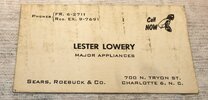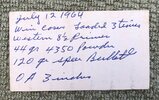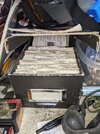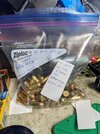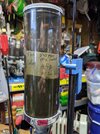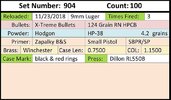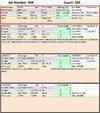GoWolfpack,, you are FULLY entitled to your opinions & ideas. And your methods work for you. Good.
However,, like Michael458,, I have loaded for many different calibers over the decades. And I have my records, (and a back-up) all the way back to the late 1970's. Plus,, I teach handloading, firearm instruction, Hunter Safety, & have been an instructor in other areas over my lifetime. In SCUBA,, as a Master Instructor Trainer, (which I used to be, now retired,) your LIFE depends upon diving safely. And you keep a dive log of every dive & record details for your safety, as well as a record of abilities.
How about flying & pilots. Ever hear of a logbook for pilots? (I was a Huey crewchief/doorgunner in the Army & had a private pilot's license several years ago.) Logbooks are a requirement for the FAA.
But my wife also used to be a paralegal.
Ever hear the word "liability?" How about things like; "Negligence," "Deliberate Indifference," Wanton Disregard for safety" or the many other terms lawyers use when suing someone,,,or a prosecutor is trying someone for a crime?
Handloading has the potential to be dangerous. As such,, record keeping is a must. Not just for your own safety,, but for others around you. A mind can forget little things,, or as mentioned above,, get something wrong. That's why we use current manuals,, and keep records.
And you may think; "I'm the only one shooting this ammo, and it's safe." Well, if you have something change,, and you do not know it,, (think of how a powder may have changed by the factory,) and you are on a range, and a gun blows up, and injures the person next to you, who may be a family member,, will you be able to answer the grilling questions by your family? Or worse,, you injure or kill a stranger,, and the other family sues you. Can you handle that?
In handloading,, I teach & preach; "Safety First" just like I do when teaching someone to shoot.
And most guns can be a bit "different" in the accuracy dept with different loads. Quite often, a firearm can only be accurate with a specific load. And accuracy testing for handguns to serious handgunners,, (the folks who hunt, or shoot silhouette, long range target shooters,) starts at 25 yds for beginning testing,, with 100 yds being the place many want their handguns to be accurate.
Accuracy is what most desire when assembling a load,, and that is usually followed by building a load for that one gun.
But,, if casual plinking at 3-7 yds is all a person does,, and finds a simple load that the powder measure throws the same for a couple of calibers, and they never need to do anything different,, then it can work. Usually.
I guess it all comes down to safety and the personal attitude a handloader has.
I also assume you have a job that never requires any form of records?



